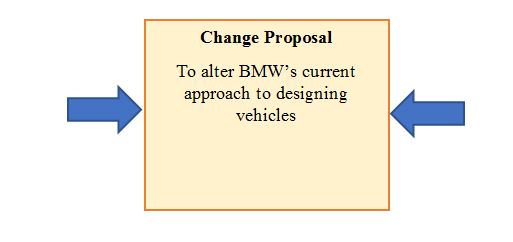Introduction: Force Field Analysis
The company selected for the proposal is BMW AG. It has always been known as one of the leaders of the machine-building industry. The brand has its own unique reputation and has always been associated with the recognizable and attractive style peculiar to its vehicles (BMW Group, 2021). The unusual design, combined with the high quality of the manufactured cars, contributed to creating the iconic image and the stable client’s interest in its products (BMW Group, 2022). Nowadays, the company fosters the implementation of innovative and green technologies focusing on creating environmentally-friendly vehicles (Ward, 2021). However, as the part of a new campaign, the approach to design was also altered. The new cars fail to meet clients’ expectations and are viewed as less attractive or not interesting for clients (Vaugh, 2021). It influences the brand’s position in the market and its ability to compete with rivals.
Under these conditions, the proposed change focuses on the necessity to alter the vehicles’ design to ensure the growing public interest in BMW products. In such a way, the following goal is formulated:
To alter BMW’s current approach to designing cars to increase profitability, improve brand reputation, and customer satisfaction.
Achievement of this goal will help to restore the company’s image and return to leading positions. The planned change requires the design team to reconsider the existing view and offer new projects with the classic BMW style and recognizable elements.
Forces for Change
The successful change process demands an in-depth analysis of the company and market to determine the elements that might promote and restrain the alteration. Thus, investigating BMW’s state at the moment, several critical forces for change can be outlined and ranked, using the scale from 1 (the weakest) to 5 (the strongest) (Crosby, 2020; Mind Tools Content Team, n.d.). First of all, the unattractive vehicle’s design is the major factor proving the need for the company’s strategy reconsideration, and it should be viewed as the potent force (Cameron & Green, 2019). Second, the lack of client satisfaction reduces to the decline in sales, which is another factor promoting change (Kartaiava et al., 2016). It also introduces the need to increase revenue by meeting the diversified customers’ requirements.
Some external factors also indicate the necessity of new goals and methods. First, the pressure from competitors who are viewed as more attractive for clients should be considered. Second, the fast-changing clients’ requirements and tastes should also be taken as a critical aspect influencing BMW’s strategy (Kelsall, 2021). Moreover, the company has to continue integrating green technologies combined with innovative and unusual styles of its vehicles. In this regard, the following forces for change and their power can be outlined:
- Unattractive vehicles’ design (5)
- Declining sales (5)
- Need to increase revenue (3)
- Pressure from rivals (3)
- Altering client’s requirements and taste (5)
- Need to continue the shift to green technologies (2)
Forces Against Change
However, some factors can negatively influence the change process and prevent the company from attaining the existing goal. These forces against change should also be considered when planning the strategy to avoid failures. First, the current approach to design might be viewed as satisfactory by some managers and be supported by their attitudes (Kincki & Soignet, 2021). These two factors should be addressed as they might demand additional effort. Moreover, the company’s current strategy and advertising campaigns are focused on promoting and popularizing the existing models, which can also slow down the possible alteration.
Finally, BMW is an international corporation with numerous production assets. It means that a change in existing strategy might demand additional investment to realign manufacturing lines and focus on creating new vehicles. Additionally, the company has numerous agreements with suppliers, meaning that any change might require reconsideration of existing obligations and additional negotiations. In such a way, the following forces against change are formulated:
- Existing approach to design (5)
- Current company’s strategy (4)
- Attitudes among managers (2)
- Need for additional investment (5)
- Obligations toward suppliers (4)
Using the Kurt Lewin model, the following graphical representation of the discussed forces and their influences can be suggested:

Conclusion
Altogether, the analysis of the forces for and against change shows that BMW should initiate the planned alteration to attain the current goal. All investigated factors have a potentially strong impact on the proposed reconsideration; however, the comparison shows that driving forces are stronger (23 to 20). It means that BMW might succeed in introducing a new vehicles’ design as both internal and external factors indicate the critical need for this process. It will increase clients’ satisfaction and their readiness to buy new cars offered by the well-known brand. It will also help BWM to remain one of the leaders and struggle against the closest rivals.
References
BMW Group. (2021). Half-year report. Web.
BMW Group. (2022). Investor presentation. Web.
Cameron, E., & Green, M. (2019). Making sense of change management: A complete guide to the models, tools and techniques of organizational change (5th ed.). Kogan Page.
Crosby, G. (2020). Planned change. Routledge.
Mind Tools Content Team. (n.d.). Force field analysis. Web.
Kartaiava, H., Kotler, P., & Setiawan, I. (2016). Marketing 4.0: Moving from traditional to digital. Wiley.
Kelsall, H. (2021). BMW really needs to change its design language and fast. Hotcars. Web.
Kincki, A., & Soignet, D. (2021). Management: A practical introduction. McGraw Hill.
Vaugh, M. (2021). Every now and then BMW design appears to lose its mind. RoadTrack. Web.
Ward, P. (2021). Why BMW design will stay polarising on purpose. Autocar. Web.